There are nine national parks in Ethiopia: The Semien Mountain National Park (in the northern mountain massif); the Awash National Park (east of the capital); the Omo and Mago National Parks (southwest of the capital); the Shalla-Abijatta Lakes National Park (in the great rift valley); the Gambella National Park; the Nechi Sar National Park, Yangudi-Rassa National Park and the Bale Mountains National Park, on high southern moorland country, which has its own unique flora and fauna.
Semien national park was firstly gazette in 1969 and registered in 1978 as the first Ethiopian world natural heritage and covers an area of 245 sqkm. Due to its unique, scenery landscape and biodiversity of fauna and flora were the criteria to be register as the first Ethiopian world natural heritage. The semien mountain massif is one of the major highland of Africa rising to the highest point in Ethiopia, Ras Dejen (4560 m), which is the fourth highest peak in the continent. Although in Africa, not far from equator, snow and ice appear on the highest points, and nights temperature often fall below zero.

The semien mountains, north of Gondar, provide an excellent trekking area with a good infrastructure of equipment provision and guide facilities in place. This park has spectacular views and a large varieties of wildlife, including Gelada Baboons, Walia Ibex, Ethiopian wolves and birds of prey such as the rare lammergeyer, a huge vulture.
The park is made up of a rocky massif, which slopes down to grassland-the massif is cut by streams and gorges. The national park has three general botanical regions. The lower slopes have been cultivated and grazed, while the alpine region (up to 3600m) are forested. The higher lands are mountain grasslands with fescue grasses as well as heather, splendid Red Hot Pokers and Giant Lobelia. The park was created primarily to protect the the walia ibex, a type of wild goat, and over 1000 are said to live in the park. However, it is easy to spot a troops of Gelada Baboon in the alpine region, but rare to see the Ethiopian wolf. The Ethiopian wolf is one of the endangered mammals and only found in the Simien and Bale mountain, is rarely seen by visitor. Over 50 bird species have been reported in the Simien mountain national park.
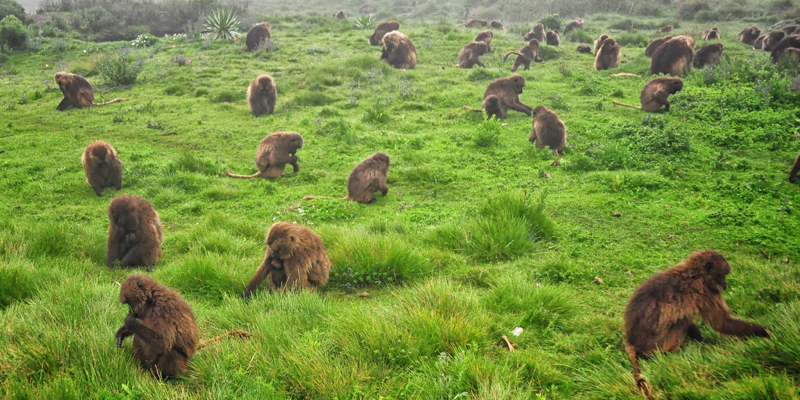
Bale Mountains National Park is 2,400 square kilometers (1,488 square miles) in area, covering a wide range of habitats and ranging in altitude from 1,500 to 4,377 meters (4,920 to 14,357 feet), southern Ethiopia's highest point. The spectacular Harenna escarpment running from east to west divides the area into two major parts. To the north is a high-altitude plateau area, formed of ancient volcanic rocks and dissected by many rivers and streams that have cut deep gorges into the edges. In some places this has resulted in scenic waterfalls. Bale mountain national park is the largest area of Afro-alpine habitat in the whole of continent. It gives the visitor opportunities for unsurpassed mountain walking, horse trekking, scenic driving and the chance to view many of Ethiopian’s endemic mammals, mainly the mountain Niyala and Ethiopian wolf, and birds, such as the Thick-billed Raven, watled ibis, Blue-winged Goose, and Rouges.
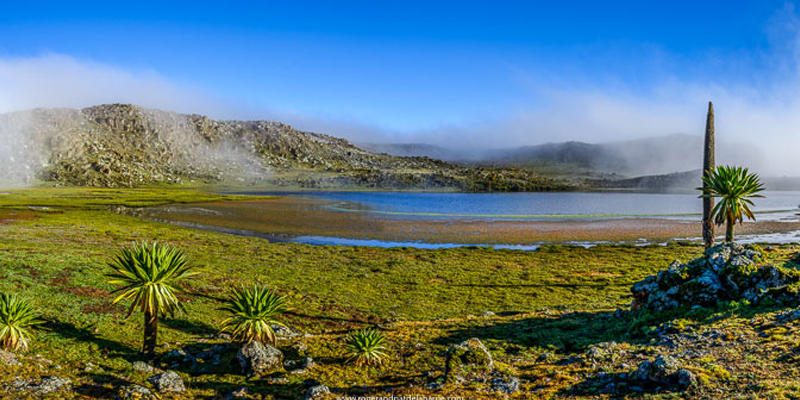
The vegetation here varies according to altitude. Around Dinsho, in the north, there are grass riverine plains, bordered by bands of bushes, particularly sagebrush and St. John's wort. Wild flowers, such as lobelia, geraniums, 'red-hot pokers', and Alchemitta, form carpets of colour. Higher up the mountains heather appears either as small bushes or as mature trees.
The high Sanetti Plateau, at 4,000 metres (13,120 feet), is characterized by Afro-alpine plants, some coping with the extreme temperatures by becoming small and others by becoming large. The best example of the latter is the giant lobelia; whose stems stand high against the skyline. Wild flowers are many and various, the dominant plant being the Helichrysum, or 'everlasting' flowers. The everlastings can be seen in many forms, but the grey bushes of H. splendidum are most striking, especially when covered with their yellow flowers. The vegetation on the plateau has to contend with tile ludtiy species of rodents found here. The southern part of the park is heavily forested after the land falls away from the: high plateau in a dense heather belt. The heather forest is particularly mature here, draped with many lichens. The wildlife of Bale includes many endemic species. The park was originally established to protect the mountain Nyala and the Ethiopian wolf.

The mountain Nyala are best seen in the Gavsav area of the north where they spread out over the grass plains. Other wildlife in this area includes Menelik's bushbuck an endemic subspecies in which the males are a very dark colour, numerous Bohor reedbuck, grey duiker, warthog, serval cat, colobus monkey, and Anubis baboon. The high plateau is noted for the Ethiopian Wolf; whose chestnut-red coat is in strong contrast to the grey vegetation. It preys on the numerous species of rodent found here, the biggest being the giant mole-rat. This subterranean animal, endemic to the Bale Mountains, can weigh as much as one kilo. The forest of the south is so thick that animals are difficult to see, but there are three species of pig here - warthog, bushpig, and giant forest hog. There are also lion, leopard, spotted hyena, and, rarely, African hunting dog, which is normally found in a much more open habitat.
Bale's birds include sixteen endemic species, many of which are easily seen. These include wattled ibis, black-winged lovebird, blue-winged goose, Rouget's rail, and thick-billed raven. Wattled cranes are often seen breeding on the high plateau in the wet season.
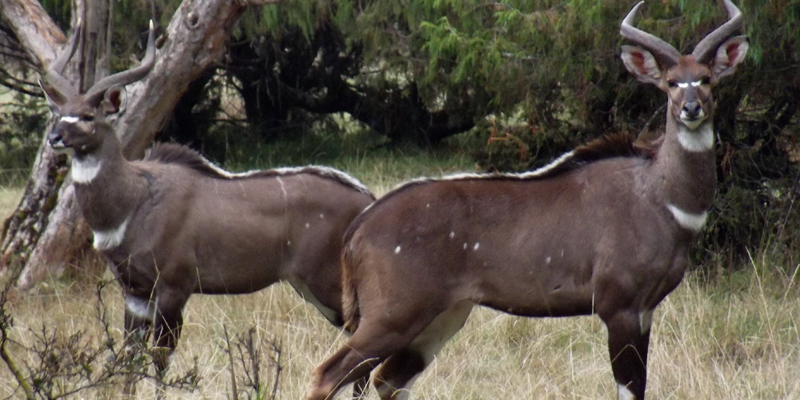
Awash national park is located in the lowlands 225 km east of Addis Ababa, south boundary of the park is formed by the awash river which swings north soon after leaving the park and eventually disappear into the afar (Danakil region). The park covers an area of 827 sqkm, most of it lies at an altitude of 900 m. In the middle of the park is the dormant volcano of fental, reaching a height of 2007 m at its top. There is an abounded of wildlife inside the Awash national park such as big game animals and diversified bird species that you can easily spot from a short ditance.

Beside to the game animals, Awash park is a perfect place for the bird watcher to see variety of birds’ species. The birds are numerous here, more than 300 species on record. The campsites are an excellent place to sight birds. The birds are numerous here, more than 300 species on record. The campsites are an excellent place to sight birds. There, above the quiet murmur of the river, one can hear the exuberant chatter of greenwood-hoopoes, the rollicking duel of red-and-yellow barbets, or the soft lament of the emerald-spotted wood dove — to name only a few. Carmine bee-eaters manoeuvre over the water, homing in on their airborne prey. There are several bustard species in the park and secretary birds in the grass plains. The raptors are represented by Fish eagles, tawny eagles, lanner and pygmy falcons, black-shouldered kites, and dark chanting goflfmwky. Ree-eaters and kingfishers provide splashca of colour, as do rollers. Ostriches roam the plains and the- immense lammergeyer soars above Fantale searching for bones to smash.
Yangudi Rassa National Park is located in the Afar Region, its 4730 square kilometers of territory include Mount Yangudi near the southern border, with altitudes from 400 to 1459 meters above sea level. Sandy semi-desert and wooded grassland cover by bush and thorn thickets the majority of the park's area. This national park was proposed to protect the African Wild Ass. Recently, the Wild Ass went extinct in Yagundi Rassa. However, there is a small population in the adjacent Mile-Serdo Wild Ass Reserve (8,766 km²). Large animals native to the park include Beisa Oryx, Soemmering's gazelle, gerenuk and Grevy's zebra
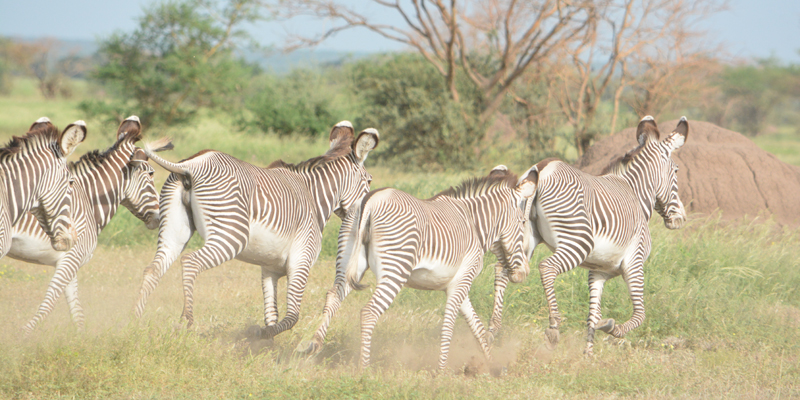
The park is in a major flyway for migrant birds’ species like the Terek Sandpiper, Common Sandpiper, Redshank, Woodchat Shrike, Lesser Grey Shrike, Black Cap and Ortolan Bunting coming from the northern hemisphere from September to January. More than 200 birds have been recorded here. Of these, no less than 23 Somali-Masai Biome species and two globally threatened species, namely, the Lesser Kestrel and Pallid Harrier are known to occur in the park. This protected area also has 36 species of mammals including Wild Ass, Beisa Oryx, Dorcas Gazelle, Hamadryas Baboon, Bat-eared Fox, Black-backed Jackal, Striped Hyena and Aardwolf.
This park is located about 200km south of Addis Ababa. Situated in the main Rift Valley, it has two beautiful lakes, Abyata and Shalla. The park is home to a few mammal species and many birds. The two lakes in the park are found side by side yet have different features. Lake Shalla is the deepest lake in the Rift Valley (260m) and Lake Abyata is the shallowest (13m). Lake Abyata is home to enormous numbers of big game as well as nesting birds whereas Lake Shalla is devoid of birds. An ostrich farm is another charm in this national park and it is the only park where ostriches can be seen in large numbers.
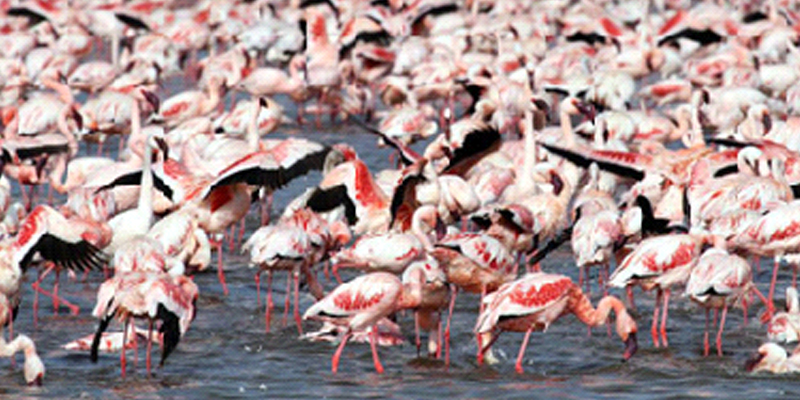
This park is found near the southern end of the Rift Valley system. Bordering the two beautiful Rift Valley lakes, Abaya and Chamo, it possesses extraordinary landscapes as well as exotic flora and fauna. The endemic mammal Swayne’s hartebeest is exceptionally found in this park. Lion, leopard, gazelle, baboon and other mammals are also commonly sighted here. The two lakes in the park are also home to exotic marine life. Hippos and crocodiles live here in colonies.
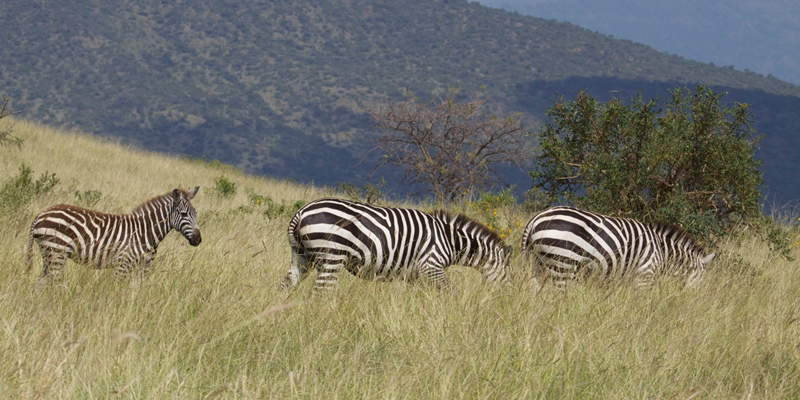
Located at the southernmost part of Ethiopia, Omo National Park extends along the banks of the Omo River. Unlike the other national parks, this park has a rich wild animal reserve of big game such as elephant, buffalo, lion, cheetah, leopard, giraffe, etc. This park is also home to the Mursi people, who are regarded as the most interesting in the Omo Valley. Known by their lower lip streching, settled by the banks of the Omo River. The park offers wildlife and virgin culture in one package.
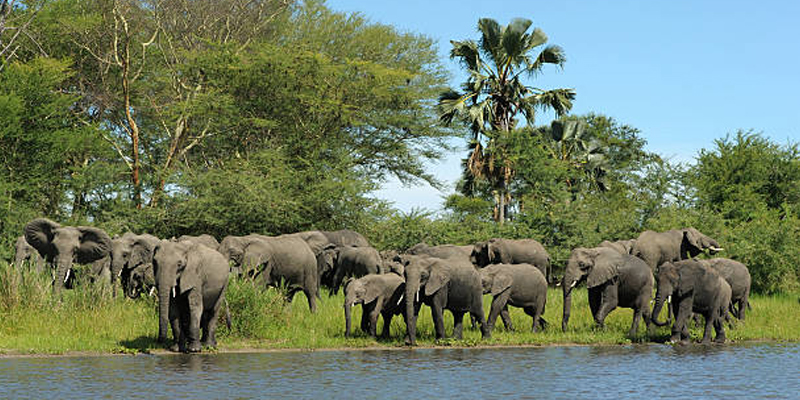
Mago National Park is situated in the same corner as Omo National Park and the two are separated by the Omo River, which drains into Kenya. This park features the same wildlife as Omo National Park. However, Mago National Park is not inhabited by Omotic tribes as in the Omo National Park. The two adjacent parks can be seen in the same tour package and are East African treasures.
Gambella National park is located 850 km west of Addis Ababa and the largest of the national parks in Ethiopia, covering 5,061 square kilometers. Originally the park was created to protect the extensive swamp habitat and its wildlife.

Gambella National Park is homed for several African big game wildlife such as Nile lechwe, the white-eared kob Roan antelope, topi, elephant, buffalo, giraffe. The banks of the baro river are rich in birdlife and thus give visitors an extra advantage. The unusual whale-headed stork is also to be found here.
+251918040958
historicabyssinia@gmail.com
teodrosnegesse16@gmail.com